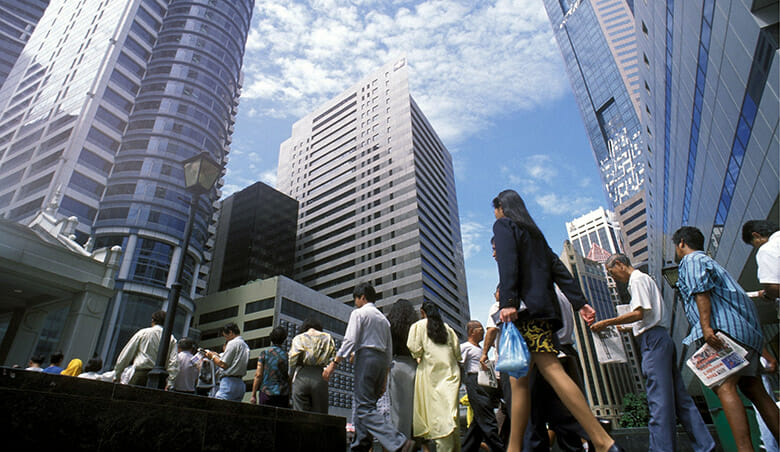
The Clifford Centre at Raffles Place will close for redevelopment. (Source: Getty Images)
Singapore’s retail property market has ended a three-year freefall as vacancy in the third quarter reached its lowest level since 2019 and prime rents began heading northward, according to a recent report.
The average vacancy level for retail space in Southeast Asia’s wealthiest city fell to a three-year low of 7.8 percent last quarter, from 8.2 percent in the three months prior, according to the report from Savills Research. That level of empty shops was also lower than the 8.1 percent rate seen in the third quarter of last year, mainly thanks to recovering foot traffic from consumers and returning tourists.
Better take-up rates were seen across all locations, particularly in top shopping hubs in the central region and inner suburbs where rents have shown resilience in the past three months. Prime retail rents in the Orchard Road area inched up by 1 percent during the third quarter from the previous three months, with rates in the suburbs climbing by 0.7 percent, the report showed. Both areas outperformed the city-wide average which fell for a third straight quarter.
With the strong showing from July through September, Savills said that Singapore retail rents for the full year of 2022 will likely register a rebound from last year’s 6.8 percent slump, but cautioned that future growth will be tempered by rising inflation and a gloomy economic outlook.
Prime Rents Creep Northward
During the third quarter Singapore’s suburban shopping districts, referred to locally as the Outside Central Region or OCR, registered the lowest vacancy levels among all locations in the city-state, with the level of empty streetfront shops and mall space remaining unchanged from the previous three months at 5.1 percent.

Alan Cheong, head of research and consultancy at Savills Singapore
The Central Region, including the famous Orchard Road shopping belt, saw vacancy dip 0.5 percent points to 9.3 percent during the period.
“As Singapore’s retail scene sees more traffic in physical stores, the sense of a gradual return to normalcy is giving retailers confidence,” the report said. “The occupancy rate in the Central Region improved on the back of an increase in appetite for taking up retail space across all areas, particularly in the Rest of Central Area and Fringe Area.”
While take-up rates are improving across the Lion City, rents are rebounding at varying paces. Savills data shows that with vacancies dropping, prime rents in the Orchard area climbed to an average of S$21.30 ($15.68) per square foot in the July through September period, while suburban rents rose to S$23.20 per square foot in that interval.
The two featured locations outperformed average rents across the city-state as measured by Singapore’s Urban Redevelopment Authority. A URA retail rental index covering the city-state as a whole fell by 0.4 percent in the third quarter from the preceding three months to extend a 0.5 percent quarterly dip recorded in the April through June period.
In the city centre, Savills said retail rents are “firming” with more workers going back to office and with supply tightening. Singapore Land Group’s plan to close the Clifford Centre in Raffles Place near the end of the year for redevelopment will also boost occupancy as it reduces the total stock available in the market with Savills seeing the potential for rapid growth in leasing rates.
“The low base effect coupled with inflation-driven increases in sales revenues and mall service charges should spill over to rents,” said Alan Cheong, the property agency’s executive director of research for Singapore.
Tenant Mix Evolves
Savills now forecasts that by the end of 2022 prime rental rates in the city centre will have climbed 3 percent from the end of last year, while predicting that suburban locations will register 2 percent growth.
The agency pointed to the ongoing recovery in the travel and consumer sectors as the primary growth drivers but cautioned that rising inflation and a slowing economy will likely dampen consumer sentitment.
The potential for a rebound in shop rents could shift the types of stores operating in Singapore’s most popular locations, according to Savills, which foresees some retailers being priced out of the market.
“As landlords’ rental expectations rise, tenants operating at thin margins amid escalating operating costs could either be forced to cease their business or relocate to less prime locations,” the report stated.
“The vacated space will be backfilled by well-performing retailers or new entrants who are willing to match up to the new rental expectations. This could potentially alter the retail mix in the market as reshuffling of tenants continues, attracting different kinds of retailers,” it added.
For 2023, the agency projects that rental growth will remain muted with an increase of around 1 to 2 percent expected for the Orchard Road area and between 2 to 3 percent for suburban locations.
Leave a Reply